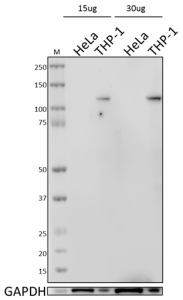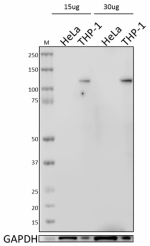- Clone
- 6H9B13 (See other available formats)
- Regulatory Status
- RUO
- Other Names
- NLR family CARD domain-containing protein 4, CARD, LRR, and NACHT-containing protein (CLAN), Caspase recruitment domain-containing protein 12 (CARD12), Ice protease-activating factor (IPAF)
- Isotype
- Mouse IgG2a, κ
- Ave. Rating
- Submit a Review
- Product Citations
- publications

-

Total cell lysates (15 or 30 µg total protein) from HeLa (negative) and THP-1 (positive) cells were resolved by 4-12% Bis-Tris gel electrophoresis, transferred to a nitrocellulose membrane, and probed with 1.0 µg/mL Purified anti-NLRC4 Antibody, clone 6H9B13, overnight at 4°C. Proteins were visualized by chemiluminescence detection using HRP goat anti-mouse IgG Antibody (Cat. No. 405306) at a 1:3000 dilution. Direct-Blot™ HRP anti-GAPDH Antibody (Cat. No. 607904) was used as a loading control at a 1:50000 dilution (lower). Lane M: Molecular Weight marker. -
_Antibody_IF_032614.jpg&Height=80&altFmImage_path=&Compression=90&Crop=5)
THP-1 cells were stained with purified anti-NLRC4 (6H9B13) antibody, followed by staining with DyLight™ 488 conjugated goat anti-mouse IgG (green) antibody. Nuclei were stained with DAPI (blue).
| Cat # | Size | Price | Quantity Check Availability | Save | ||
|---|---|---|---|---|---|---|
| 659702 | 100 µg | £182 | ||||
NLRC4 , also known as IPAF, is a member of the NOD-like receptor (NLR) family. The NLR proteins share a conserved DNA-binding NACHT domain, a caspase recruitment domain (CARD), and a leucine-rich repeat (LRR) domain responsible for pathogen pattern recognition. NLRC4 was found to play an important role in the innate immune response against bacterial infection. During Gram-negative bacteria infections, such as Shigella, Salmonella, Legionella, or Pseudomonas, NLRC4 detects and is activated by translocated bacterial flagellin or PrgJ-like rod proteins subsequently resulting in the assembly of the NLRC4 inflammasome. The activated inflammasome drives proteolytic activation of caspase-1, leading to the processing and secretion of the proinflamatory cytokines IL-1β and IL-18.
Product DetailsProduct Details
- Verified Reactivity
- Human
- Antibody Type
- Monoclonal
- Host Species
- Mouse
- Immunogen
- Partial human NLRC4 recombinant protein (1-88 aa)
- Formulation
- Phosphate-buffered solution, pH 7.2, containing 0.09% sodium azide.
- Preparation
- The antibody was purified by affinity chromatography.
- Concentration
- 0.5 mg/mL
- Storage & Handling
- The antibody solution should be stored undiluted between 2°C and 8°C.
- Application
-
WB - Quality tested
ICC - Verified - Recommended Usage
-
Each lot of this antibody is quality control tested by Western blotting. For Western blotting, the suggested use of this reagent is 0.5 - 2.5 µg per mL. It is recommended that the reagent be titrated for optimal performance for each application.
- RRID
-
AB_2563347 (BioLegend Cat. No. 659702)
Antigen Details
- Structure
- 1024 amino acids, predicted molecular weight of 116 kD. Contains a CARD domain, a NACHT domain, and 14 leucine-rich repeats.
- Distribution
-
Cytoplasm.
- Function
- NLRC4 is involved in the assembly of the inflammasome complex, activation of pro-caspase-1, and induction of matured proinflammatory cytokines during bacterial infections.
- Interaction
- Foms homo-oligomer in NLRC4 inflammasome. Interacts with Caspase-1, ASC, NOD2, NALP1, and BCL10.
- Cell Type
- Dendritic cells
- Biology Area
- Cell Biology, Immunology, Innate Immunity, Signal Transduction
- Antigen References
-
1. Cai S, et al. 2012. J. Immunol. 188:5623.
2. Franchi L, et al. 2012. Nat. Immunol. 13:449.
3. Carvalho FA, et al. 2012. Mucosal Immunol. 5:288.
4. Tomalka J, et al. 2011. PLoS Pathog. 7:e1002379.
5. Pereira MS, et al. 2011. J. Immunol. 187:6447.
6. Sauer JD, et al. 2011. Proc. Natl. Acad. Sci. USA. 108:12419. - Gene ID
- 58484 View all products for this Gene ID
- UniProt
- View information about NLRC4 on UniProt.org
Related FAQs
Other Formats
View All NLRC4 Reagents Request Custom Conjugation| Description | Clone | Applications |
|---|---|---|
| Purified anti-NLRC4 (IPAF) | 6H9B13 | WB,ICC |
Compare Data Across All Formats
This data display is provided for general comparisons between formats.
Your actual data may vary due to variations in samples, target cells, instruments and their settings, staining conditions, and other factors.
If you need assistance with selecting the best format contact our expert technical support team.
 Login / Register
Login / Register 





_Antibody_IF_032614.jpg&Width=150&altFmImage_path=&Crop=5)



Follow Us